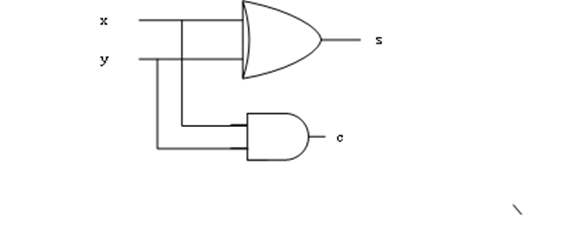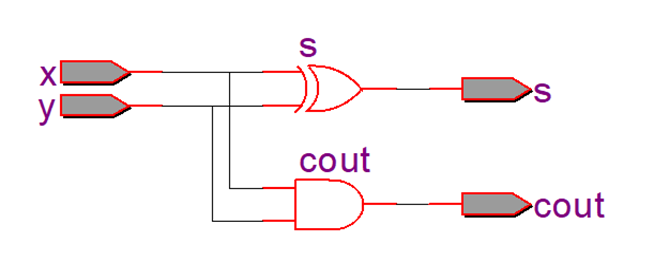两个一位的二进制数x,y相加,假设和为s,进位为cout,其真值表为:
从真值表中,我们可以得到:s = x^y, cout = x&y,用以下的电路,可以实现两个一位数的相加,该电路称为半加器。
实现该电路的verilog代码如下:

module halfadd(x,y,s,cout); input x; input y; output s; output cout; assign s = x^y; assign cout = x&y; endmodule
相对应的testbench文件如下代码。在代码中,我们采用系统函数$random来产生随机激励。半加器电路中并没有使用时钟,但在testbench中,产生了时钟信号,主要是为了功能验证时候,有一个时间单位信号,便于检查结果。

`timescale 1ns/1ns
`define clock_period 20
module halfadd_tb;
reg x,y;
wire cout;
wire s;
reg clk;
halfadd halfadd_0(
.x(x),
.y(y),
.s(s),
.cout(cout)
);
initial clk = 0;
always #(`clock_period/2) clk = ~clk;
initial begin
x = 0;
repeat(20)
#(`clock_period) x = $random;
end
initial begin
y = 0;
repeat(20)
#(`clock_period) y = $random;
end
initial begin
#(`clock_period*20)
$stop;
end
endmodule
在quartus II中,分析与综合后,用rtl view 可以得到 halfadd的电路如下,和我们预想的一样。
功能仿真结果如下,从波形中可以看到结果正确。
全编译后,在Cyclone IV E-EP4CE10F17C8中的门级仿真结果如下,输入和输出之间,会有几ns的时延。





